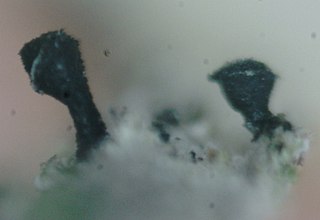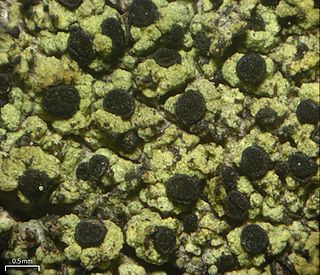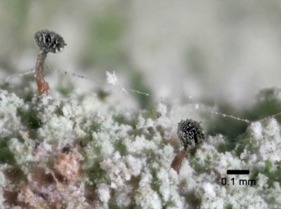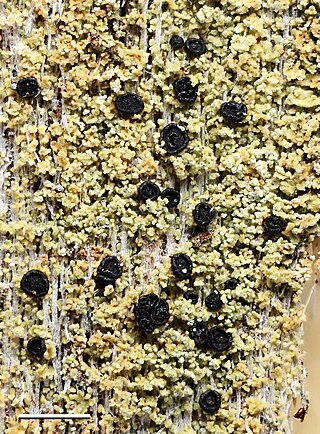
Calicium is a genus of leprose lichens. It is in the family Caliciaceae, and has 40 species.

The Caliciaceae are a family of mostly lichen-forming fungi belonging to the class Lecanoromycetes in the division Ascomycota. Although the family has had its classification changed several times throughout its taxonomic history, the use of modern molecular phylogenetic methods have helped to establish its current placement in the order Caliciales. Caliciaceae contains 39 genera and about 670 species. The largest genus is Buellia, with around 300 species; there are more than a dozen genera that contain only a single species.

Calicium abietinum, commonly known as fir pin or black stubble, is a crustose lichen that is found growing on trees throughout much of the world.
Calicium chlorosporum is a crustose lichen that is found growing on trees throughout much of the world.

Calicium glaucellum is a crustose lichen that is found growing on trees throughout much of the world. The species is similar to Calicium abietinum.

Calicium viride, commonly known as the green stubble lichen, is a species of pin lichen in the family Caliciaceae, and the type species of the genus Calicium. It is a common and widely distributed species in temperate areas of the Northern Hemisphere and southern South America.

Allocalicium is a single-species fungal genus in the family Caliciaceae. It is monotypic, containing the single pin lichen species Allocalicium adaequatum. This lichen occurs in North America, South America, Europe, and the Russian Far East, where it grows on branches and twigs of deciduous trees and shrubs, typically those of alder and poplar. The species was originally described in 1869 as a member of Calicium, but molecular phylogenetics analysis demonstrated it was not a member of that genus and so Allocalicium was created to contain it.

Calicium trabinellum, commonly known as the yellow-collar stubble lichen, is a widespread species of pin lichen in the family Caliciaceae. It was first described by Swedish lichenologist Erik Acharius in 1803 as Calicium xylonellum ß trabinellum. He made the new combination Calicium trabinellum in a later chapter of the same publication.
Calicium carolinianum is a species of lichen in the family Caliciaceae. It is endemic to the Gulf Coastal Plain region of the United States. The lichen contains norstictic acid, and has ascospores that measure 13–17 by 8–9 μm.

Atla is a genus of crustose lichens in the family Verrucariaceae. It has nine species that grow on rocks or on soil.

Calicium pinicola is a species of lignicolous (wood-dwelling), crustose lichen in the family Caliciaceae. It is widely distributed in Europe, and also occurs in the United States.

Thelomma santessonii, the tan nipple lichen, is a species of saxicolous (rock-dwelling), crustose lichen in the family Caliciaceae. Found in northern North America, it was formally described as a new species in 1976 by lichenologist Leif Tibell. It is endemic to the coast and islands of Southern California and Baja California in Mexico.
Hypogymnia tenuispora is a rare species of foliose lichen in the family Parmeliaceae. Found in China's Yunnan province, it is characterised by its uniquely narrow ascospores and crowded lobes, which help distinguish it from other similar Hypogymnia species.
Amandinea pilbarensis is a little-known species of crustose lichen in the family Physciaceae, First described in 2020, it is found in Australia. It is similar to Amandinea polyxanthonica, but can be distinguished by its smaller ascospores and the presence of calcium oxalate and thiophanic acid in the medulla.
Filsoniana ferdinandmuelleri is a species of saxicolous (rock-dwelling), crustose lichen in the family Teloschistaceae. It is found in Australia. The lichen has a squamulose (scaly) thallus, with a range of bright yellow to greenish-yellow and brownish-orange colours in its soredia and apothecia, respectively. The areoles of this lichen are varied in size, slightly raised from the thallus surface, and each carries one to four apothecia. The soralia are rounded or irregularly shaped, covering most of the thallus surface as a yellow to greenish-yellow mass. The apothecia have dark brownish-orange discs, surrounded by slightly paler yellow margins, with the spore-bearing asci containing typically eight brownish-golden ascospores.

Chaenothecopsis kilimanjaroensis is a species of lichenicolous (lichen-dwelling) pin lichen in the family Mycocaliciaceae. Found in the cloud forests of Tanzania, it was described as a new species in 2019. These tiny lichens have a short stalk, which can be either single or formed in aggregates on the same thallus. The stalks are medium brown at the base and become translucent in water. This species has unique spores, which contain a single septum, are arranged in a single row in the ascus, and have a surface ornamented with elongated, blister-like structures.
Marchantiana occidentalis is a species of corticolous and saxicolous, crustose lichen in the family Teloschistaceae. It is found in Western Australia, usually as an inhabitant of dry twigs, bark, or wood of various plant species, but occasionally on granite rock outcrops. It forms a well-developed thallus, shiny and composed of tiny dark greenish to brown areoles, with sizes typically ranging from 5–15 mm, though larger aggregations are possible. It features numerous rounded apothecia scattered across its surface, varying in form and colour, with a distinct margin and disc.

Pseudothelomma ocellatum is a species of lignicolous (wood-dwelling), crustose lichen in the family Caliciaceae. This lichen is characterised by its grey, areolate thallus that produces abundant lichenised diaspores, such as short spherical isidia and coarse, dark brown-black soredia. It is typically sterile, meaning apothecia are absent.
Calicium brachysporum is a species of leprose lichen in the family Caliciaceae.

Xylopsora canopeorum is a squamulose (scaly), corticolous (bark-dwelling) lichen species in the family Umbilicariaceae. Discovered in the canopies of Sequoia sempervirens in California, United States, it was formally described as new to science in 2018. It is endemic to the central coastal region of California, living within the unique ecosystems of Big Basin Redwoods State Park and Armstrong Redwoods State Natural Reserve, areas known for their ancient coast redwood forests. The lichen evolves from a crust-like to scale-like form, developing into coral-like crusts as it matures, complemented by distinctive flat, black reproductive discs. This species has varying greyish-green to medium brown coloration and occasionally forms soralia, which release powdery reproductive propagules called soredia. Xylopsora canopeorum is distinguished from closely related species by its smaller, partly coral-like squamules (scales), the occurrence of soralia on its surface, and in some specimens, the presence of both thamnolic and friesiic acids within the thallus.










